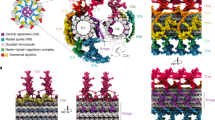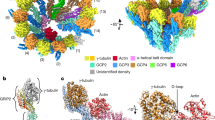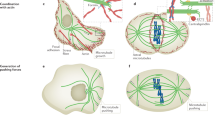Abstract
Microtubules are indispensable for Golgi complex assembly and maintenance, which are integral parts of cytoplasm organization during interphase in mammalian cells. Here, we show that two discrete microtubule subsets drive two distinct, yet simultaneous, stages of Golgi assembly. In addition to the radial centrosomal microtubule array, which positions the Golgi in the centre of the cell, we have identified a role for microtubules that form at the Golgi membranes in a manner dependent on the microtubule regulators CLASPs. These Golgi-derived microtubules draw Golgi ministacks together in tangential fashion and are crucial for establishing continuity and proper morphology of the Golgi complex. We propose that specialized functions of these two microtubule arrays arise from their specific geometries. Further, we demonstrate that directional post-Golgi trafficking and cell migration depend on Golgi-associated CLASPs, suggesting that correct organization of the Golgi complex by microtubules is essential for cell polarization and motility.
This is a preview of subscription content, access via your institution
Access options
Subscribe to this journal
Receive 12 print issues and online access
$209.00 per year
only $17.42 per issue
Buy this article
- Purchase on Springer Link
- Instant access to full article PDF
Prices may be subject to local taxes which are calculated during checkout








Similar content being viewed by others
References
Walczak, C. E. and Heald, R. Mechanisms of mitotic spindle assembly and function. Int. Rev.Cytol. 265, 111–158 (2008).
Karsenti, E. et al. Interconversion of metaphase and interphase microtubule arrays, as studied by the injection of centrosomes and nuclei into Xenopus eggs. J. Cell Biol. 98, 1730–1745 (1984).
Zhai, Y. et al. Microtubule dynamics at the G2/M transition: abrupt breakdown of cytoplasmic microtubules at nuclear envelope breakdown and implications for spindle morphogenesis. J. Cell Biol. 135, 201–214 (1996).
Bulinski, J. C., Richards, J. E. & Piperno, G. Posttranslational modifications of α tubulin: detyrosination and acetylation differentiate populations of interphase microtubules in cultured cells. J. Cell Biol. 106, 1213–1220 (1988).
Gundersen, G. G., Gomes, E. R. & Wen, Y. Cortical control of microtubule stability and polarization. Curr. Opin. Cell Biol. 16, 106–112 (2004).
O'Connell, C. B. and Khodjakov, A. L. Cooperative mechanisms of mitotic spindle formation. J. Cell Sci. 120, 1717–1722 (2007).
Efimov, A. et al. Asymmetric CLASP-dependent nucleation of noncentrosomal microtubules at the trans-Golgi network. Dev. Cell. 12, 917–930 (2007).
Tang, D. et al. Molecular mechanism of mitotic Golgi disassembly and reassembly revealed by a defined reconstitution assay. J. Biol. Chem. 283, 6085–6094 (2008).
Cole, N. B. et al. Golgi dispersal during microtubule disruption: regeneration of Golgi stacks at peripheral endoplasmic reticulum exit sites. Mol. Biol. Cell 7, 631–650 (1996).
Allan, V. J., Thompson, H. M. & McNiven, M. A. Motoring around the Golgi. Nature Cell Biol. 4, E236–E242 (2002).
Burkhardt, J. K., The role of microtubule-based motor proteins in maintaining the structure and function of the Golgi complex. Biochim. Biophys. Acta 1404, 113–126 (1998).
Thyberg, J. & Moskalewski, S. Role of microtubules in the organization of the Golgi complex. Exp. Cell Res. 246, 263–279 (1999).
Bornens, M. Organelle positioning and cell polarity. Nature Rev. Mol. Cell Biol. 9, 874–886 (2008).
Kirschner, M. & Mitchison, T. Beyond self-assembly: from microtubules to morphogenesis. Cell 45, 329–342 (1986).
Storrie, B. & Yang, W. Dynamics of the interphase mammalian Golgi complex as revealed through drugs producing reversible Golgi disassembly. Biochim. Biophys. Acta 1404, 127–137 (1998).
Faire, K. et al. E-MAP-115 (ensconsin) associates dynamically with microtubules in vivo and is not a physiological modulator of microtubule dynamics. J. Cell Sci. 112, 4243–4255 (1999).
Burkhardt, J. K. et al. Overexpression of the dynamitin (p50) subunit of the dynactin complex disrupts dynein-dependent maintenance of membrane organelle distribution. J. Cell Biol. 139, 469–484 (1997).
Roghi, C. & Allan, V. J. Dynamic association of cytoplasmic dynein heavy chain 1a with the Golgi apparatus and intermediate compartment. J. Cell Sci. 112, 4673–4685 (1999).
Quintyne, N. J. & Schroer, T. A. Distinct cell cycle-dependent roles for dynactin and dynein at centrosomes. J. Cell Biol. 159, 245–254 (2002).
Mellman, I. & Simons, K. The Golgi complex: in vitro veritas? Cell 68, 829–840 (1992).
Puthenveedu, M. A. et al. GM130 and GRASP65-dependent lateral cisternal fusion allows uniform Golgi-enzyme distribution. Nature Cell Biol. 8, 238–248 (2006).
Feinstein, T. N. & Linstedt, A. D. GRASP55 regulates Golgi ribbon formation. Mol. Biol. Cell 19, 2696–2707 (2008).
Lippincott-Schwartz, J., Cole, N. & Presley, J. Unravelling Golgi membrane traffic with green fluorescent protein chimeras. Trends Cell Biol. 8, 16–20 (1998).
Taraska, J. W. et al. Secretory granules are recaptured largely intact after stimulated exocytosis in cultured endocrine cells. Proc. Natl Acad. Sci. USA 100, 2070–2075 (2003).
Bruun, A., Tornqvist, K. & Ehinger, B. Neuropeptide Y (NPY) immunoreactive neurons in the retina of different species. Histochemistry 86, 135–140 (1986).
Yadav, S., Puri, S. & Linstedt, A. D. A primary role for Golgi positioning in directed secretion, cell polarity, and wound healing. Mol. Biol. Cell 20, 1728–1736 (2009).
Prigozhina, N. L. & Waterman-Storer, C. M. Protein kinase D-mediated anterograde membrane trafficking is required for fibroblast motility. Curr. Biol. 14, 88–98 (2004).
Small, J. V. & Kaverina, I. Microtubules meet substrate adhesions to arrange cell polarity. Curr. Opin.Cell Biol. 15, 40–47 (2003).
Noritake, J. et al. IQGAP1: a key regulator of adhesion and migration. J. Cell Sci. 118, 2085–2092 (2005).
Drabek, K. et al. Role of CLASP2 in microtubule stabilization and the regulation of persistent motility. Curr. Biol. 16, 2259–2264 (2006).
Daly, R. J. Cortactin signalling and dynamic actin networks. Biochem. J. 382, 13–25 (2004).
Cytrynbaum, E. N., Rodionov, V. & Mogilner, A. Computational model of dynein-dependent self-organization of microtubule asters. J. Cell Sci. 117, 1381–1397 (2004).
Linstedt, A. D. Positioning the Golgi apparatus. Cell 118, 271–272 (2004).
Rios, R. M. et al. GMAP-210 recruits γ-tubulin complexes to cis-Golgi membranes and is required for Golgi ribbon formation. Cell 118, 323–335 (2004).
Shorter, J. & Warren, G. Golgi architecture and inheritance. Annu. Rev. Cell Dev. Biol. 18, 379–420 (2002).
Puthenveedu, M. A. & Linstedt, A. D. Subcompartmentalizing the Golgi apparatus. Curr. Opin. Cell Biol. 17, 369–375 (2005).
Rivero, S. et al. Microtubule nucleation at the cis-side of the Golgi apparatus requires AKAP450 and GM130. EMBO J. advance online publication doi:10.1038/emboj.2009.47 (26 February 2009).
Hayes, G. L. et al. Multiple Rab GTPase binding sites in GCC185 suggest a model for vesicle tethering at the trans Golgi. Mol. Biol. Cell 20, 209–217 (2009).
Lansbergen, G. et al. CLASPs attach microtubule plus ends to the cell cortex through a complex with LL5β. Dev. Cell 11, 21–32 (2006).
Wittmann, T. & Waterman-Storer, C. M. Spatial regulation of CLASP affinity for microtubules by Rac1 and GSK3β in migrating epithelial cells. J. Cell Biol. 169, 929–939 (2005).
Mimori-Kiyosue, Y. et al. CLASP1 and CLASP2 bind to EB1 and regulate microtubule plus-end dynamics at the cell cortex. J. Cell Biol. 168, 141–153 (2005).
Patel, H. et al. The multi-FERM-domain-containing protein FrmA is required for turnover of paxillin-adhesion sites during cell migration of Dictyostelium. J. Cell Sci. 121, 1159–1164 (2008).
Thomas, J. H. & Wieschaus, E. src64 and tec29 are required for microfilament contraction during Drosophila cellularization. Development 131, 863–871 (2004).
Acknowledgements
We thank James Goldenring, Mathew Tyska and Ryoma Ohi for helpful discussions, and Anna Akhmanova, Laura A. Lee and Steven K. Hanks for critical reading of the manuscript. This study was funded by NIH NIGMS grant 1R01GM078373-01 to I.K. and a pilot project to I.K. from NIH NCI GI SPORE grant P50CA095103. A.R.R.M. was supported by Fundação para a Ciência e Tecnologia fellowship SFRH/BD/32976/2006 and by grant PTDC/SAU-OBD/66113/2006 from Fundacao para a Ciencia e a Tecnologia of Portugal. P.M.M. was supported by American Heart Predoctoral grant 09PRE2260729.
Author information
Authors and Affiliations
Contributions
P.M.M. performed most experiments and data analysis and co-wrote the manuscript. A.W.F. contributed to experiments and data quantification. A.R.R.M. contributed to mitosis experiments. N.E. contributed to experiments and provided technical assistance. A.E. performed microtubule tip tracking experiments for Fig. 4a, b. I.K. contributed to experiments, directed all of the work and project planning, and co-wrote the manuscript.
Corresponding author
Ethics declarations
Competing interests
The authors declare no competing financial interests.
Supplementary information
Supplementary Information
Supplementary Information (PDF 840 kb)
Supplementary Information
Supplementary Movie 1 (MOV 3431 kb)
Supplementary Information
Supplementary Movie 2 (MOV 5633 kb)
Supplementary Information
Supplementary Movie 3 (MOV 5113 kb)
Supplementary Information
Supplementary Movie 4 (MOV 8416 kb)
Rights and permissions
About this article
Cite this article
Miller, P., Folkmann, A., Maia, A. et al. Golgi-derived CLASP-dependent microtubules control Golgi organization and polarized trafficking in motile cells. Nat Cell Biol 11, 1069–1080 (2009). https://doi.org/10.1038/ncb1920
Received:
Accepted:
Published:
Issue Date:
DOI: https://doi.org/10.1038/ncb1920
This article is cited by
-
Split but merge: Golgi fragmentation in physiological and pathological conditions
Molecular Biology Reports (2024)
-
Schizophrenia-associated Mitotic Arrest Deficient-1 (MAD1) regulates the polarity of migrating neurons in the developing neocortex
Molecular Psychiatry (2023)
-
Structure modeling hints at a granular organization of the Golgi ribbon
BMC Biology (2022)
-
Myotonic dystrophy RNA toxicity alters morphology, adhesion and migration of mouse and human astrocytes
Nature Communications (2022)
-
Membrane and organelle dynamics during cell division
Nature Reviews Molecular Cell Biology (2020)



